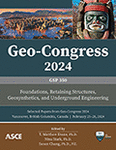Characterization of the Long-Term Tensile Stiffness of Geogrids at the Serviceability Limit of Strain
Publication: Geo-Congress 2024
ABSTRACT
The characterization of long-term tensile stiffness of geogrids is required for various geotechnical applications, such as the design of geosynthetic-reinforced load transfer platforms within column-supported embankments. While ultimate creep strain information is generally included in manufacturer-provided product data sheets, current recommendations for the estimation of the long-term tensile stiffness of geogrids at the serviceability limit of strain require interpretation of isochronous curves not readily available to practitioners. Therefore, reduction factors generated for ultimate creep strain failure are often used for serviceability loading conditions, a method which has not been validated. This paper presents a method for appropriately scaling available ultimate creep strain information to obtain reduction factors for the serviceability limit creep strain. For a variety of geogrids, reduction factors estimated using the proposed method and direct use of the reduction factor at rupture are compared to reduction factors generated with interpreted values from isochronous curves. Results of the proposed scaling framework show good agreement with factors from the interpretation of isochronous curves; additionally, results suggest that the direct use of the reduction factor at rupture may be acceptable.
Get full access to this article
View all available purchase options and get full access to this chapter.
REFERENCES
ASTM. ASTM D4595. (2017). Standard Test Method for Tensile Properties of Geotextiles by the Wide-Width Strip Method. ASTM International, West Conshohocken, PA.
ASTM. ASTM D6637. (2016). Standard Test Method for Determining Tensile Properties of Geogrids by the Single or Multi-Rib Tensile Method. ASTM International, West Conshohocken, PA.
ASTM. ASTM D6992. (2016). Standard Test Method for Accelerated Tensile Creep and Creep-Rupture of Geosynthetic Materials Based on Time-Temperature Superposition Using the Stepped Isothermal Method. ASTM International, West Conshohocken, PA.
Berg, R. R., B. R. Christopher, and N. C. Samtani. (2009). “ Design of Mechanically Stabilized Earth Walls and Reinforced Soil Slopes – Volume I.” US Department of Transportation Federal Highway Administration.
Filz, G. M., J. A. Sloan, M. P. McGuire, and M. Smith. (2019). “Settlement and Vertical Load Transfer in Column-Supported Embankments.” Journal of Geotechnical and Geoenvironmental Engineering, 145 (10).
Kaliakin, V. N., M. Dechasakulsom, and D. Leshchinsky. (2000). “Investigation of the Isochrone Concept for Predicting Relaxation of Geogrids.” Geosynthetics International, 7 (2): 79–99.
Koerner, R. M., G. Koerner, and Y. Hsuan. (2014). Creep Tension Testing of Geosynthetics. Geosynthetic Institute, Folsom, PA.
Li, A. L., and R. K. Rowe. (2001). “Influence of Creep and Stress-Relaxation of Geosynthetic Reinforcement on Embankment Behavior.” Geosynthetics International, 8 (3): 233–270.
Schaefer, V. R., R. R. Berg, J. G. Collin, B. R. Christopher, J. A. DiMaggio, G. M. Filz, D. A. Bruce, and D. Ayala. (2017). “ Ground Modification Methods Reference Manual – Volume II.” US Department of Transportation Federal Highway Administration.
Watts, G. R. A., K. C. Brady, and M. J. Greene. (1998). The creep of geosynthetics. Transport Research Laboratory, Berkshire, U.K.
Information & Authors
Information
Published In
History
Published online: Feb 22, 2024
Authors
Metrics & Citations
Metrics
Citations
Download citation
If you have the appropriate software installed, you can download article citation data to the citation manager of your choice. Simply select your manager software from the list below and click Download.
